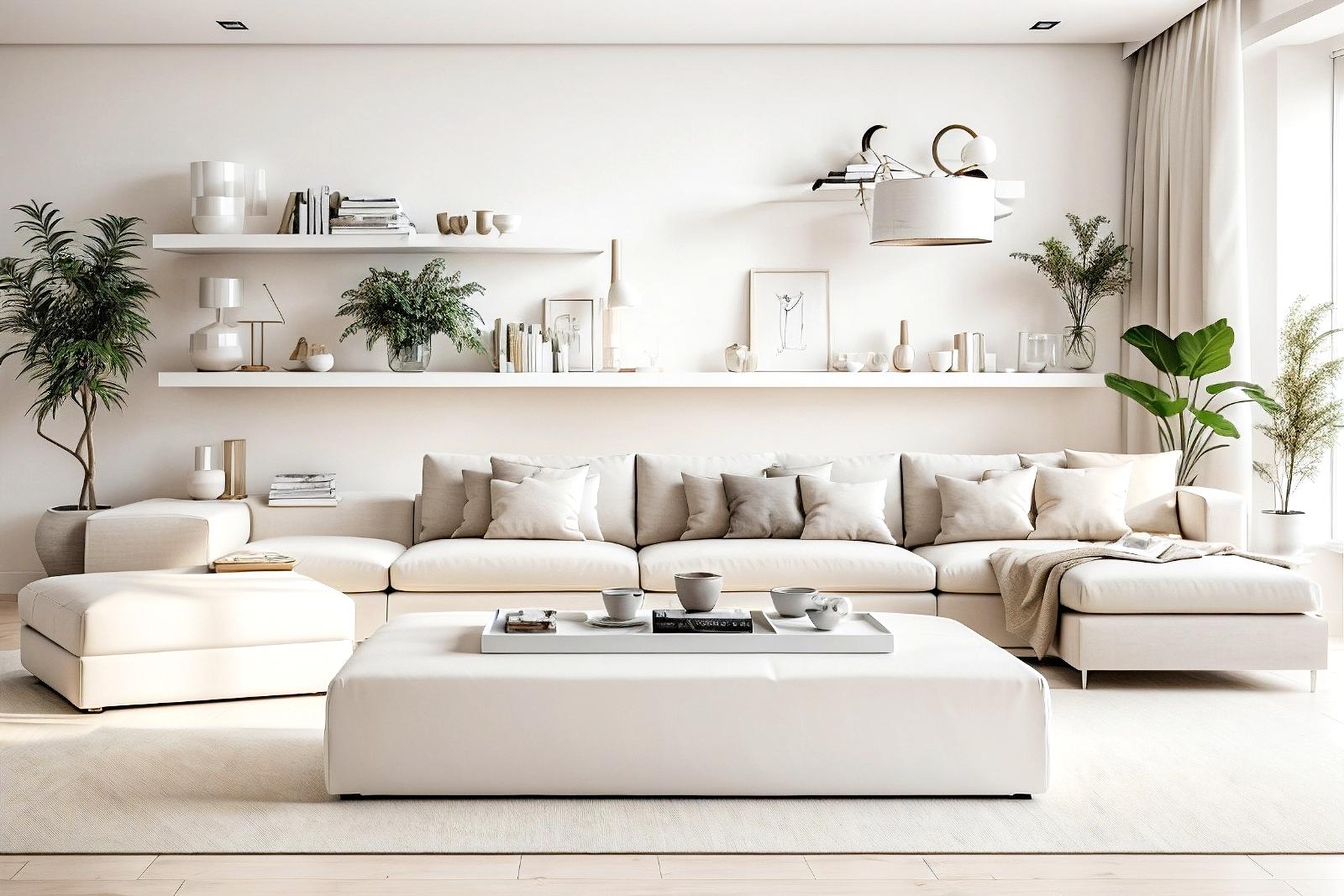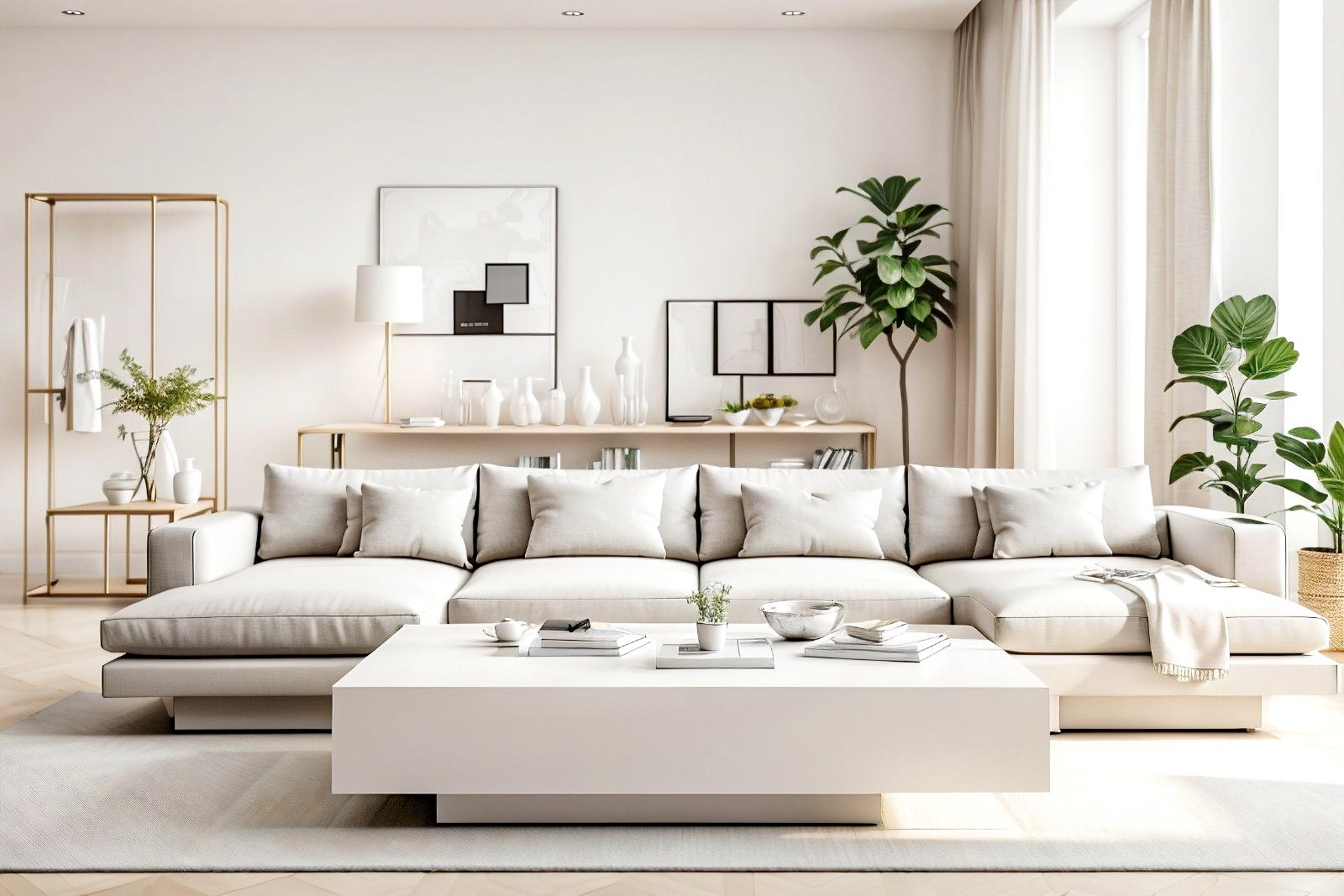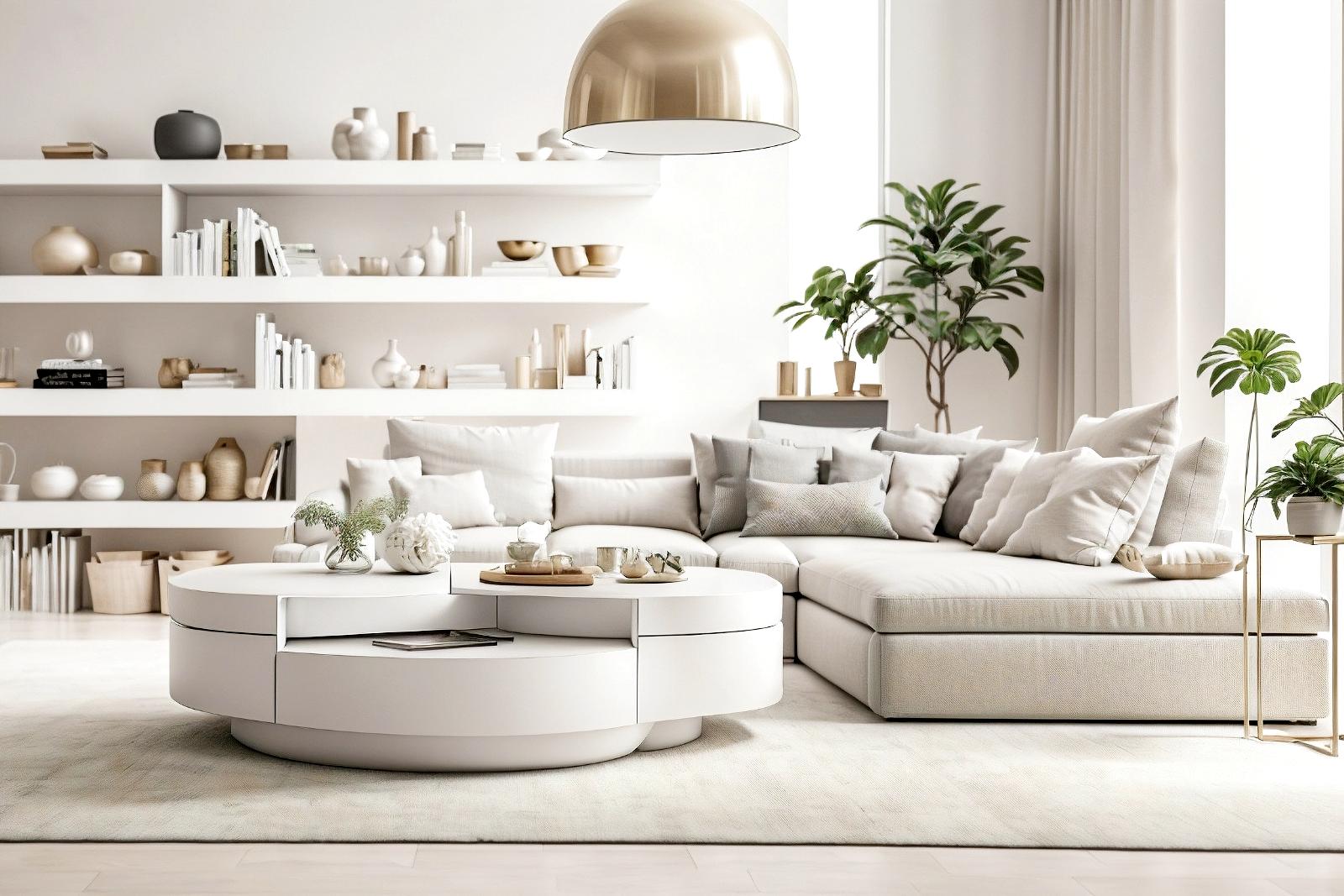- Understanding Minimalist Home Decor
- Organization Systems
- Storage Solutions
- Furniture Selection
- Inspiration for Minimalist Home Decor and Organization
Home decor minimalism and decluttering offer a range of benefits for individuals seeking a simpler and more streamlined lifestyle. Some key advantages include:
1. Enhanced aesthetics:
By adopting a minimalist approach to home decor, you can create a clean, elegant, and visually appealing living space. Clutter-free environments promote a sense of calmness, organization, and beauty.
2. Reduced stress and anxiety:
Living in an uncluttered and well-organized space can have a significant impact on your mental well-being. Decluttering eliminates visual distractions and creates a peaceful atmosphere, reducing stress and promoting relaxation.
3. Increased productivity:
A cluttered environment can hinder focus and productivity. Simplifying your living space allows you to create a more functional and efficient area. With fewer distractions and the ability to find what you need easily, you can enhance your productivity and concentration.
4. Improved functionality:
Removing unnecessary items from your home helps free up space and allows you to utilize it more effectively. You can reorganize rooms, rearrange furniture, and create functional zones for specific activities. This gives you the opportunity to make the most of your living space.
5. Time-saving and easier cleaning:
A decluttered home requires less time and effort for cleaning and maintenance. With fewer items to clean, organize, and dust, you can simplify your cleaning routine and spend your time on more meaningful activities.
6. Cost-effective:
By embracing minimalism, you become more intentional with your purchases. This can save you money in the long run as you avoid buying unnecessary items and focus on quality over quantity. You also reduce the need for storage solutions and can potentially downsize to a smaller, more affordable living space.
7. Environmental benefits:
Adopting a minimalist lifestyle encourages mindful consumption and reduces waste. By acquiring fewer items and letting go of excess possessions, you contribute to a more sustainable and eco-friendly way of living.
The benefits of home decor minimalism and decluttering extend beyond just aesthetics; they positively impact various aspects of your life, promoting a sense of tranquility, focus, functionality, and overall well-being.
Table of contents
Understanding Minimalist Home Decor
Minimalist home decor is an interior design style that seeks to create a serene and clutter-free living environment by using minimal furniture and accessories. It emphasizes simplicity, functionality, and clean aesthetics. By employing minimalist principles, you can transform your living space into a place of tranquility and beauty.
The first and foremost principle of minimalist home decor is simplicity. This means eliminating unnecessary clutter and adopting a less-is-more approach. Start by decluttering your space.
Avoid holding onto items that no longer serve a purpose or bring you joy. Instead, focus on keeping only what you truly need. This not only creates a visually appealing space but also promotes a sense of calm and relaxation.
Neutral colors play a crucial role in minimalist home decor. Shades such as white, beige, and gray dominate the color palette. These colors create a light and airy ambiance, making your space appear larger and more peaceful.
Additionally, neutral colors provide a timeless backdrop that allows you to
incorporate different styles and textures without overwhelming the aesthetic.
Clean lines are another hallmark of minimalist home decor. Opt for furniture and accessories with simple and streamlined designs. Avoid ornate details or excessive embellishments.
Smooth surfaces and straight edges add a sense of order and visual harmony to the space. Consider investing in furniture made of natural materials like wood or metal, as they often showcase clean lines and durability.
Open spaces are highly valued in minimalist home decor. Clearing your floor space and letting light flow freely can instantly make your home feel more spacious and inviting.
Consider removing unnecessary furniture and replacing heavy drapes with sheer
curtains or
blinds to maximize natural light. Open floor plans, when possible, can further enhance the feeling of openness and create a seamless flow between different areas of your home.
Purposeful and intentional decoration choices are essential in minimalist home decor. Each item in your space should have a specific function or bring you joy. Avoid unnecessary decorations that serve no practical purpose.
Instead, focus on quality over quantity, selecting a few carefully curated pieces that add value and reinforce the minimalist aesthetic. Choose functional storage solutions to keep your space organized and maintain its clutter-free appeal.
By embracing simplicity, using neutral colors, incorporating clean lines, and maximizing open spaces, you can create a harmonious and serene home environment. Remember to make purposeful and intentional decoration choices, allowing your space to reflect your personal taste and lifestyle.
Minimalist home decor is about creating a calming and clutter-free living space. By understanding its principles and aesthetics, such as simplicity, neutral colors, clean lines, and open spaces, you can cultivate a serene and inviting atmosphere.
Intentionally selecting functional and meaningful decor items will further enhance the minimalist aesthetic. With a focus on purpose and a commitment to minimalism, you can create a home that promotes clarity, tranquility, and beauty.
Table of contents
Organization Systems
One of the key aspects of effective organization systems is maximizing storage space. Hidden storage is a fantastic solution to keep your belongings neatly tucked away. Consider furniture pieces such as ottomans or coffee tables with hidden compartments to store items like blankets, books, or even remote controls.
Another idea is to use storage benches in entryways, where you can keep shoes, hats, and scarves out of sight. By utilizing hidden storage, you can maintain a clean and minimalist look while still having your essentials close at hand.
Multi-purpose furniture is another great addition to your organization systems. Opt for pieces that serve more than one function to make the most out of your space.
For example, a
sofa bed can double as a guest bed, while a desk with built-in shelves provides both workspace and storage. This way, you can maximize the functionality of your furniture while reducing the number of separate pieces.
Vertical space utilization is a must in any organization system. When floor space is limited, turning to the walls is a smart move. Install shelving units or floating shelves to store books, decorative items, or even kitchen essentials.
Don't forget about utilizing the space above doors and cabinets too. Hanging hooks or small shelves can hold items like bags or towels. By going vertical, you can make the most of every nook and cranny in your space.
Now that we've explored some creative storage ideas, let's dive into minimalist organizing tools that can help enhance your organization systems. Baskets are a versatile option that can be used in almost any room. They come in various sizes and materials, allowing you to store items like toys, magazines, or extra blankets. Plus, baskets add a touch of natural texture and warmth to your space.
Trays are another fantastic organizing tool that can help corral items in a stylish and practical manner. Use them on coffee tables or entryway consoles to keep keys, wallets, and other daily essentials in one place. Trays not only create visual order but also make it easy to tidy up quickly when needed.
Drawer dividers are a game-changer for keeping your drawers neat and tidy. From kitchen utensils to
home office supplies, dividers help separate items and prevent them from getting mixed together. There are various types of dividers available, from adjustable ones to custom-made ones. Choose the option that best suits your needs and enjoy the ease of finding exactly what you're looking for in seconds.
By incorporating hidden storage, multi-purpose furniture, and vertical space utilization, you can effectively declutter and make the most out of your space. Don't forget to embrace minimalist storage ideas such as baskets, trays, and drawer dividers to keep your belongings in order.
Organizing is an ongoing process, and it's essential to establish routines to maintain your organized space. Regularly decluttering, sorting, and tidying up will become second nature, resulting in a space that not only looks great but also functions efficiently.
Table of contents
Storage Solutions
In our fast-paced modern lives, finding innovative ways to maximize storage space has become a necessity. Minimalist storage solutions not only declutter our homes but also bring a sense of calm and order to our daily lives.
1. Bedroom Storage Solutions:
a) Under-bed Storage:
Utilize the often-overlooked space under your bed by investing in under-bed storage containers or repurposing old drawers with wheels. These provide ample room to store bulky items such as seasonal clothes, extra bedding, or even sports equipment.
b) Wall Shelving:
Install wall-mounted shelves to keep your bedside essentials, books, or decorative items within arm's reach. Opt for minimalist designs that blend seamlessly with your
bedroom decor, creating a visually pleasing yet functional storage solution.
c) Closet Organization:
Maximize the storage potential of your closet by using adjustable shelves, hanging organizers, and dividers. Utilize vertical space effectively, such as hanging shoe racks or installing shelf dividers for folded garments, to create a neat and
organized closet.
2. Kitchen Storage Solutions:
a) Floating Shelves:
Add both practicality and style to your kitchen by installing floating shelves. These shelves are perfect for displaying your favorite cookbooks, spice jars, and kitchen utensils, while also freeing up valuable counter space.
b) Magnetic Strips and Racks:
Maximize the empty space on your kitchen walls by installing magnetic strips or racks. Utilize them to neatly hang knives, spice jars, or metal utensils, keeping your countertops clear and your cooking essentials easily accessible.
c) Drawer Dividers:
Tame unruly kitchen drawers by using dividers to separate utensils, gadgets, and cutlery. This allows for efficient organization and simplifies the process of finding and retrieving items when needed.
3. Living Room Storage Solutions:
a) Multi-functional Furniture:
Opt for furniture pieces that double as storage, such as ottomans with hidden compartments or coffee tables with built-in shelves or drawers. These smart choices help to declutter your living room while providing a stylish and seamless storage solution.
b) Wall-mounted TV Units:
Instead of a bulky entertainment center, consider installing a wall-mounted TV unit with shelves or cabinets. This sleek option not only saves floor space but also provides ample storage for media consoles, DVDs, and decorative items.
c) Baskets and Decorative Boxes:
Utilize decorative baskets or boxes as stylish storage solutions in your living room. Place them strategically near seating areas to store blankets, pillows, or remote controls, ensuring that everything has its designated place.
Cost-effective DIY Organization Ideas:
1. Repurpose Old Furniture:
Give new life to old dressers, cabinets, or bookshelves by repainting or refinishing them. This budget-friendly option allows you to create bespoke storage solutions tailored to your specific needs.
2. DIY Wall-Mounted Shelves:
Build your own wall-mounted shelves using reclaimed wood or repurposed materials. This personalized approach not only saves money but also adds a touch of uniqueness to your home decor.
3. Reusable Containers and Jars:
Save money on expensive storage containers by upcycling glass jars, plastic bins, or cardboard boxes. Label them clearly and stack them neatly to create an organized and functional storage system.
Exploring minimalist storage solutions can transform your home into an organized and serene haven. By implementing smart storage options such as wall shelving, floating shelves, and under-bed storage, you can declutter each room efficiently.
With cost-effective DIY organization ideas, you can create personalized storage systems that cater to your specific needs. Remember, a well-organized home not only enhances functionality but also promotes a peaceful and enjoyable living environment.
Table of contents
Furniture Selection
When it comes to decorating your living space, choosing the right furniture can make all the difference in achieving a minimalist aesthetic. Minimalism is all about simplicity, functionality, and creating an uncluttered environment. To help you select the perfect pieces for your minimalist-inspired home, here are some valuable tips and insights based on my in-the-field experience.
1. Prioritize Functionality:
One of the key elements of minimalist furniture design is functionality. Look for furniture that serves a specific purpose and provides practical solutions. For example, consider a sleek
dining table with built-in storage compartments or a coffee table with hidden drawers. These multi-functional pieces can help you maximize your space while still maintaining a minimalist look.
2. Opt for Clean Lines:
Minimalist furniture pieces often feature clean lines and simple silhouettes. Avoid furniture with elaborate ornamentation or excessive details. Instead, select items with sleek and straight edges that contribute to a coherent and uncluttered look. For instance, a streamlined sofa or a modern bed frame with clean lines can be excellent choices.
3. Choose Neutral Colors:
Neutral colors, such as white, gray, or beige, are highly recommended for minimalist furniture. They create a calm and harmonious atmosphere while allowing other elements in the room to stand out. Additionally, sticking to neutral colors ensures the furniture pieces will seamlessly blend with any future changes or renovations you may undertake.
4. Embrace Minimalist Materials:
Natural materials are a staple in minimalist furniture design. Opt for furniture made from materials such as wood, leather, or metal. These materials offer durability, timeless appeal, and they age gracefully over time. Remember to choose high-quality materials to ensure the longevity of your furniture pieces.
5. Evaluate Space-saving Solutions:
In smaller living spaces, space-saving furniture is invaluable. Look for items that provide additional storage, like bed frames with built-in drawers or ottomans that can be used for both seating and storage. A minimalistic approach encourages you to make the best use of every inch of your room, so think vertically as well by utilizing wall-mounted shelves or floating cabinets.
6. Consider Scale and Proportions:
When selecting furniture, ensure that it complements the scale and proportions of your room. Oversized or undersized pieces can throw off the balance and disrupt the minimalist ambiance. Pay attention to the dimensions of your space and choose furniture that fits appropriately without overpowering or crowding the room.
7. Quality Over Quantity:
Minimalism promotes the idea of having fewer but higher quality possessions. Rather than cluttering your space with numerous pieces, choose a few well-designed and well-crafted furniture items that will stand the test of time. Investing in quality furniture not only enhances the aesthetic appeal but also ensures long-term satisfaction.
Minimalism is not solely an aesthetic choice but a lifestyle change. It encourages intentionality and mindfulness in your furniture selections. By incorporating these tips into your decision-making process, you can curate a space that is both visually pleasing and functional, creating a minimalist haven that reflects your personal style.
Table of contents
Inspiration for Minimalist Home Decor and Organization
In a world cluttered with material possessions, many individuals are finding solace in the minimalist movement, which encourages simplicity, focus, and tranquility in their living spaces. Minimalist home decor and organization not only create aesthetically pleasing environments but also provide a sense of harmony and balance.
1. Embrace Simplicity and Functionality:
Minimalist home decor centers around the principle of "less is more." By opting for clean lines, uncluttered spaces, and functional pieces, you can create an atmosphere that is visually appealing while still being highly practical.
- Furniture: Choose pieces that are sleek and simple in design. For example, a mid-century modern sofa with clean lines and neutral hues can become a focal point while maintaining a minimalist aesthetic.
- Color Palette: Stick to a neutral color palette, focusing on whites, grays, and pastel tones. This will promote a calm and cohesive ambiance that allows for accentuating key elements.
- Lighting: Natural light should be maximized, as it creates an open and airy feel. Additionally, incorporate minimalistic light fixtures that complement the overall design without overpowering it.
2. Declutter and Organize:
An essential aspect of minimalist home decor is decluttering and organizing your space, ensuring everything has a designated place to avoid unnecessary distractions and maintain a sense of order.
- Storage Solutions: Utilize smart storage options like closed cabinets, built-in shelves, and under-bed drawers to keep belongings hidden and maintain a clutter-free appearance. Opt for multifunctional furniture such as ottomans with hidden storage compartments or minimalist wall-mounted shelving units.
- Sorting and Simplifying: Implement a strict "one in, one out" rule as you declutter your home. Assess each item and consider its usefulness and sentimental value. Sell, donate, or recycle items that you no longer need, freeing up precious space.
- Display Thoughtful Accents: Minimalist decor doesn't mean stark emptiness. Showcase a few carefully selected decor items, like a piece of artwork or a single plant, to bring warmth and character to your space.
3. Unify and Streamline:
Creating a cohesive flow throughout your home is crucial when adopting minimalist home decor. It ensures visual harmony and allows spaces to feel interconnected and spacious.
- Continuity in Flooring: Consistent flooring throughout your home, such as hardwood or light-colored tiles, enhances the sense of openness and fluidity, connecting different rooms.
- Harmonious Textiles: Opt for simple, monochromatic textiles with minimal patterns. This unifies the space and avoids overwhelming visual distractions.
- Ambience Through Accents: Rely on minimalist accents like textured rugs, organic materials, and geometric patterns to add depth and interest without compromising simplicity.
Minimalist home decor and organization offer an opportunity to create tranquil and functional living spaces that bring joy to our lives. By embracing simplicity, decluttering, and prioritizing functionality, we can achieve a harmonious and visually appealing home environment.
True minimalism lies not merely in the physical aspects, but also in the emotional and mental benefits that a clutter-free space can offer. So, start your journey to a minimalist home today, and witness the transformative power it has on your well-being and overall lifestyle.
Table of contents


